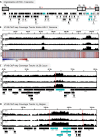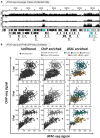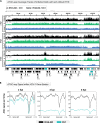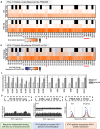The Nuclear DNA Sensor IFI16 Indiscriminately Binds to and Diminishes Accessibility of the HSV-1 Genome to Suppress Infection
- PMID: 35575489
- PMCID: PMC9239196
- DOI: 10.1128/msystems.00198-22
The Nuclear DNA Sensor IFI16 Indiscriminately Binds to and Diminishes Accessibility of the HSV-1 Genome to Suppress Infection
Abstract
Human cells identify invading pathogens and activate immune signaling pathways through a wide array of pattern recognition receptors, including DNA sensors. The interferon-inducible protein 16 (IFI16) is a nuclear DNA sensor that recognizes double-stranded DNA from a number of viral sources, including genomes of nuclear-replicating viruses. Among these is the prevalent human pathogen herpes simplex virus 1 (HSV-1). Upon binding to the HSV-1 DNA genome, IFI16 both induces antiviral cytokine expression and suppresses virus gene expression. Here, we used a multiomics approach of DNA sequencing techniques paired with targeted mass spectrometry to obtain an extensive view of the interaction between IFI16 and the HSV-1 genome and how this binding affects the viral DNA structure and protein expression. Through chromatin immunoaffinity purification coupled with next-generation DNA sequencing (ChIP-seq), we found that IFI16 binds to the HSV-1 genome in a sequence-independent manner while simultaneously exhibiting broad enrichment at two loci: UL30, the viral DNA polymerase gene, and US1 to US7. The assay for transposase-accessible chromatin with sequencing (ATAC-seq) revealed that these two regions are among the most accessible stretches of DNA on the genome, thereby facilitating IFI16 binding. Accessibility of the entire HSV-1 genome is elevated upon IFI16 knockout, indicating that expression of IFI16 globally induces chromatinization of viral DNA. Deletion of IFI16 also results in a global increase in the expression of HSV-1 proteins, as measured by parallel reaction monitoring-mass spectrometry of viral proteins representing 80% of the HSV-1 genome. Altogether, we demonstrate that IFI16 interacts with the HSV-1 genome in a sequence-independent manner, coordinating epigenetic silencing of the viral genome and decreasing protein expression and virus replication. IMPORTANCE Mammalian host defense against viral infection includes broad-acting cellular restriction factors, as well as effectors of intrinsic and innate immunity. IFI16 is a critical nuclear host defense factor and intrinsic immune protein involved in binding viral DNA genomes, thereby repressing the replication of nucleus-replicating viruses, including the human herpes simplex virus 1. What has remained unclear is where on the viral genome IFI16 binds and how binding affects both viral DNA structural accessibility and viral protein expression. Our study provides a global view of where and how a nuclear restriction factor of DNA viruses associates with viral genomes to exert antiviral functions during early stages of an acute virus infection. Our study can additionally serve as a systems-level model to evaluate nuclear DNA sensor interactions with viral genomes, as well as the antiviral outcomes of transcriptionally silencing pathogen-derived DNA.
Keywords: ATAC-seq; ChIP-seq; DNA sensor; HSV-1; IFI16; PRM; proteomics; targeted mass spectrometry; virus infection; virus-host interactions.
Conflict of interest statement
The authors declare a conflict of interest. I.M.C. and M.A.K. have a provisional patent application on a "Method for quantitative monitoring of the progression of infections with herpesviruses", which describes a herpesvirus protein detection method by targeted mass spectrometry that was in part used for validation analyses in this study.
Figures





Similar articles
-
Charge-Mediated Pyrin Oligomerization Nucleates Antiviral IFI16 Sensing of Herpesvirus DNA.mBio. 2019 Jul 23;10(4):e01428-19. doi: 10.1128/mBio.01428-19. mBio. 2019. PMID: 31337724 Free PMC article.
-
Viral DNA Sensors IFI16 and Cyclic GMP-AMP Synthase Possess Distinct Functions in Regulating Viral Gene Expression, Immune Defenses, and Apoptotic Responses during Herpesvirus Infection.mBio. 2016 Nov 15;7(6):e01553-16. doi: 10.1128/mBio.01553-16. mBio. 2016. PMID: 27935834 Free PMC article.
-
Mechanisms of Host IFI16, PML, and Daxx Protein Restriction of Herpes Simplex Virus 1 Replication.J Virol. 2018 Apr 27;92(10):e00057-18. doi: 10.1128/JVI.00057-18. Print 2018 May 15. J Virol. 2018. PMID: 29491153 Free PMC article.
-
The Role of Nuclear Antiviral Factors against Invading DNA Viruses: The Immediate Fate of Incoming Viral Genomes.Viruses. 2016 Oct 22;8(10):290. doi: 10.3390/v8100290. Viruses. 2016. PMID: 27782081 Free PMC article. Review.
-
Interrogating Host Antiviral Environments Driven by Nuclear DNA Sensing: A Multiomic Perspective.Biomolecules. 2020 Nov 24;10(12):1591. doi: 10.3390/biom10121591. Biomolecules. 2020. PMID: 33255247 Free PMC article. Review.
Cited by
-
IFI16 phase separation via multi-phosphorylation drives innate immune signaling.Nucleic Acids Res. 2023 Jul 21;51(13):6819-6840. doi: 10.1093/nar/gkad449. Nucleic Acids Res. 2023. PMID: 37283074 Free PMC article.
-
Control of HSV-1 Infection: Directions for the Development of CRISPR/Cas-Based Therapeutics and Diagnostics.Int J Mol Sci. 2024 Nov 17;25(22):12346. doi: 10.3390/ijms252212346. Int J Mol Sci. 2024. PMID: 39596412 Free PMC article. Review.
-
cGAS-STING-TBK1 Signaling Promotes Valproic Acid-Responsive Human Cytomegalovirus Immediate-Early Transcription during Infection of Incompletely Differentiated Myeloid Cells.Viruses. 2024 May 30;16(6):877. doi: 10.3390/v16060877. Viruses. 2024. PMID: 38932169 Free PMC article.
-
Epigenetic Restriction Factors (eRFs) in Virus Infection.Viruses. 2024 Jan 25;16(2):183. doi: 10.3390/v16020183. Viruses. 2024. PMID: 38399958 Free PMC article. Review.
-
Tackling cutaneous herpes simplex virus disease with topical immunomodulators-a call to action.Clin Microbiol Rev. 2025 Mar 13;38(1):e0014724. doi: 10.1128/cmr.00147-24. Epub 2025 Feb 21. Clin Microbiol Rev. 2025. PMID: 39982077 Review.
References
-
- Kerur N, Veettil MV, Sharma-Walia N, Bottero V, Sadagopan S, Otageri P, Chandran B. 2011. IFI16 acts as a nuclear pathogen sensor to induce the inflammasome in response to Kaposi sarcoma-associated herpesvirus infection. Cell Host Microbe 9:363–375. doi:10.1016/j.chom.2011.04.008. - DOI - PMC - PubMed
Publication types
MeSH terms
Substances
Grants and funding
LinkOut - more resources
Full Text Sources

